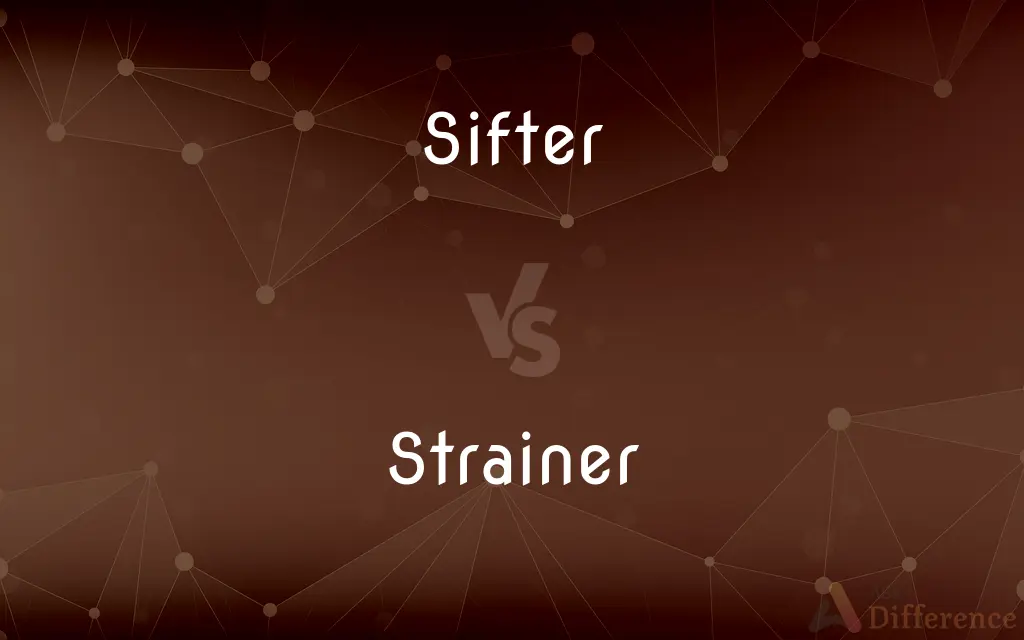Sifter vs. Strainer — What's the Difference?
Edited by Tayyaba Rehman — By Maham Liaqat — Updated on April 23, 2024
A sifter is primarily used to aerate and break up clumps in dry ingredients like flour, using a fine mesh, whereas a strainer is designed to separate solids from liquids, featuring a coarser mesh or perforations.

Difference Between Sifter and Strainer
Table of Contents
ADVERTISEMENT
Key Differences
A sifter is specifically designed for processing dry ingredients. It typically includes a mechanism like a crank or a handle that helps to push materials through a fine mesh, which not only breaks up clumps but also aerates the ingredients, such as flour, to make them lighter for baking. On the other hand, a strainer, often called a sieve, is used to separate larger solids from liquids or to remove larger particles from finer particles in both cooking and industrial applications.
Sifters are often used in baking and cooking to incorporate air into flour and other dry ingredients, which can help improve the texture of the final product, such as cakes and breads. Whereas strainers are more versatile and can be used for a variety of tasks in the kitchen, such as draining pasta, rinsing vegetables, or straining stocks and broths.
The design of a sifter usually includes a canister with a mesh bottom that is finer, allowing only very small particles to pass through. This fine mesh is crucial for achieving the desired consistency in recipes that require precision, like pastries. Conversely, strainers generally have a coarser mesh or perforations, which are suitable for a broader range of foods and are not typically used for tasks requiring fine separation.
In terms of construction, sifters may have additional features such as a squeeze handle or turning crank to facilitate the sifting process. This helps in evenly and efficiently processing the dry ingredients. Strainers, however, are simpler in design with a bowl-shaped form having larger holes that can efficiently handle the draining of liquids from various foods.
While sifters are almost exclusively used with dry ingredients, strainers are indispensable tools for both hot and cold culinary processes, making them essential for everyday cooking. They are crucial for achieving the proper texture and consistency in many dishes, emphasizing their utility beyond just separating unwanted elements.
ADVERTISEMENT
Comparison Chart
Primary Use
Aerating and breaking up clumps in dry ingredients
Separating solids from liquids, rinsing solids
Mesh Type
Fine mesh
Coarser mesh or perforations
Common Materials
Flour, powdered sugar
Pasta, vegetables, stocks
Mechanism
Often equipped with a crank or handle
Typically handheld with no moving parts
Usage Context
Baking and dry ingredient preparation
Versatile kitchen use, including hot and cold processes
Compare with Definitions
Sifter
A device with a fine mesh used for sifting dry ingredients.
She used a sifter for the flour to make her cake light and fluffy.
Strainer
Often used to strain broths or sauces.
The chef strained the stock with a fine-mesh strainer.
Sifter
Used to aerate and combine dry baking ingredients.
The recipe calls for the cocoa powder to be sifted to avoid lumps.
Strainer
A kitchen utensil with a perforated or mesh bowl.
A strainer is essential for making smooth soups.
Sifter
Breaks up clumps in powdered ingredients.
The sifter made quick work of the clumpy flour.
Strainer
A device for rinsing various foods.
He washed the berries using a strainer.
Sifter
Incorporates air into dry substances.
He sifted the confectioner's sugar for the frosting.
Strainer
Used in both hot and cold cooking processes.
The strainer was used to blanch and then cool the vegetables quickly.
Sifter
A tool with a handle used to facilitate sifting.
The old-fashioned sifter has a crank handle for easy use.
Strainer
A tool used to separate liquids from solids.
She used a strainer to drain the boiled spaghetti.
Sifter
To put (flour, for example) through a sieve in order to separate the fine from the coarse particles.
Strainer
A device having holes punched in it or made of crossed wires for separating solid matter from a liquid
A tea strainer
Sifter
To distinguish as if separating with a sieve
Sifted the candidates for the job.
Strainer
One that strains, as a device used to separate liquids from solids.
Sifter
To apply by scattering through a sieve
Sift sugar on a dessert.
Strainer
A standing or fallen tree whose branches are partly submerged in a fast-flowing river, presenting a hazard to navigation or to swimmers.
Sifter
To examine and sort carefully
Sift the evidence.
Strainer
An apparatus for tightening, stretching, or strengthening.
Sifter
To make use of a sieve.
Strainer
A device through which a liquid is passed for purification, filtering or separation from solid matter; anything (including a screen or a cloth) used to strain a liquid.
Sifter
To pass through a sieve
A meal that sifts easily.
Strainer
A perforated screen or openwork (usually at the end of a suction pipe of a pump), used to prevent solid bodies from mixing in a liquid stream or flowline.
Sifter
To make a careful examination
Sifted through back issues of the magazine.
Strainer
One who strains.
Sifter
A tool for sifting, especially one for powdered cooking ingredients.
Strainer
One who strains.
Sifter
(rare) One who sifts.
He was employed as a sifter.
Strainer
That through which any liquid is passed for purification or to separate it from solid matter; anything, as a screen or a cloth, used to strain a liquid; a device of the character of a sieve or of a filter; specifically, an openwork or perforated screen, as for the end of the suction pipe of a pump, to prevent large solid bodies from entering with a liquid.
Sifter
Any lamellirostral bird, as a duck or goose, so called because it sifts or strains its food from the water and mud by means of the lamellae of the beak.
Strainer
A filter to retain larger pieces while smaller pieces and liquids pass through
Sifter
One who, or that which, sifts.
Sifter
Any lamellirostral bird, as a duck or goose; - so called because it sifts or strains its food from the water and mud by means of the lamell of the beak.
Sifter
A household sieve (as for flour)
Common Curiosities
What makes a sifter different in design from a strainer?
Sifters often have mechanical elements like cranks or handles to help sift ingredients more efficiently.
Can I use a strainer to sift flour?
While possible, a strainer's coarser mesh might not aerate the flour as effectively as a sifter.
Is a strainer useful for making beverages?
Yes, strainers are excellent for removing solids from homemade beverages like juices or cocktails.
Why might a baker prefer a sifter over a strainer?
For baking, a sifter is preferable as it aerates flour and ensures even mixing without clumps.
Which is more versatile, a sifter or a strainer?
Strainers are more versatile, useful for a range of tasks beyond just separating solids and liquids.
What should I look for when buying a sifter?
Look for one with a comfortable handle and fine, durable mesh.
Is there a hybrid tool that combines features of both a sifter and a strainer?
While hybrid tools exist, they may not perform all specific tasks of each as effectively.
Can a sifter be used with wet ingredients?
Sifters are generally not recommended for wet ingredients as they can clog the fine mesh.
What is the key difference in the mesh of a sifter and a strainer?
A sifter has a finer mesh suitable for dry ingredients, while a strainer has coarser mesh or perforations for liquids.
How does the use of a strainer affect the texture of food?
It ensures smoother textures by removing excess liquid and finer impurities.
Can a strainer handle hot ingredients?
Yes, most strainers are designed to handle hot ingredients like pasta or hot broth.
How does the material of a sifter or strainer affect its use?
Materials like stainless steel are durable and suitable for both hot and cold uses.
Why is it important to strain stocks or broths?
Straining helps achieve a clear and pure flavor profile by removing solid residues.
What are some examples of using a sifter in recipes?
Sifters are used in recipes for cakes, breads, and pastries to improve texture.
What are common mistakes in using strainers and sifters?
Using a strainer for dry ingredients can result in uneven texture, and using a sifter for wet ingredients can lead to clogging.
Share Your Discovery

Previous Comparison
Favouriting vs. Favoriting
Next Comparison
Adapt vs. AdoptAuthor Spotlight
Written by
Maham LiaqatEdited by
Tayyaba RehmanTayyaba Rehman is a distinguished writer, currently serving as a primary contributor to askdifference.com. As a researcher in semantics and etymology, Tayyaba's passion for the complexity of languages and their distinctions has found a perfect home on the platform. Tayyaba delves into the intricacies of language, distinguishing between commonly confused words and phrases, thereby providing clarity for readers worldwide.














































